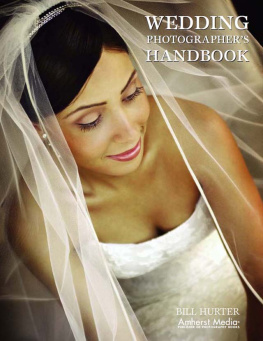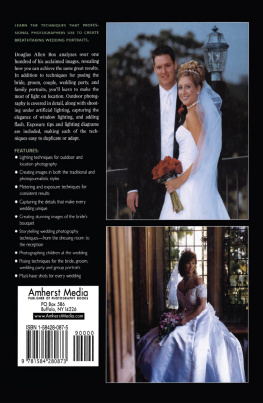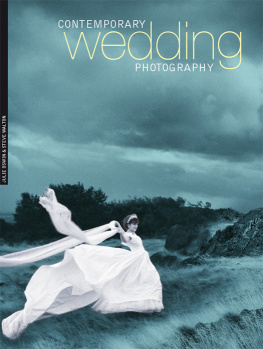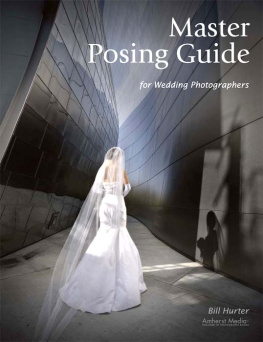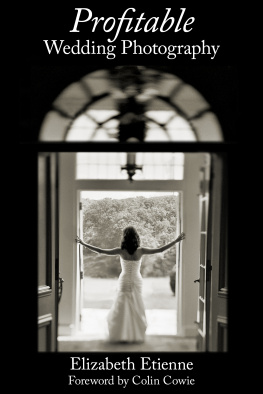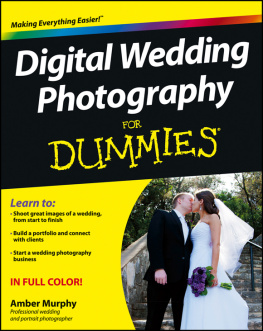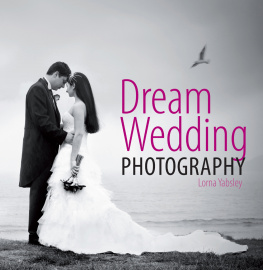Copyright 2007 by Bill Hurter.
All rights reserved.
Front cover photograph by Frank Cava.
Back cover photograph by Cal Landau.
Published by:
Amherst Media, Inc.
P.O. Box 586
Buffalo, N.Y. 14226
Fax: 716-874-4508
www.AmherstMedia.com
Publisher: Craig Alesse
Senior Editor/Production Manager: Michelle Perkins
Assistant Editor: Barbara A. Lynch-Johnt
ISBN-13: 978-1-58428-192-4
Library of Congress Card Catalog Number: 2006925660
Printed in Korea.
10 987654321
No part of this publication may be reproduced, stored, or transmitted in any form or by any means, electronic, mechanical, photocopied, recorded or otherwise, without prior written consent from the publisher.
Notice of Disclaimer: The information contained in this book is based on the authors experience and opinions. The author and publisher will not be held liable for the use or misuse of the information in this book.
TABLE OF CONTENTS
ABOUT THE AUTHOR
Bill Hurter started out in photography in 1972 in Washington, DC, where he was a news photographer. He even covered the political sceneincluding the Watergate hearings. After graduating with a BA in literature from American University in 1972, he completed training at the Brooks Institute of Photography in 1975. Going on to work at Petersens PhotoGraphic magazine, he held practically every job except art director. He has been the owner of his own creative agency, shot stock, and worked assignments (including a year or so with the L.A. Dodgers). He has been directly involved in photography for the last thirty years and has seen the revolution in technology. In 1988, Bill was awarded an honorary Masters of Science degree from the Brooks Institute. He has written more than a dozen instructional books for professional photographers and is currently the editor of Rangefinder magazine.
1
INTRODUCTION
I n the earliest days of photography, weddings were photographed in styles that captured the bride and groom in very formal poses. Even with the emergence of the contemporary wedding album, which included group portraits of statuesque groomsmen and bridesmaids and the bride and groom with family members, posing remained stiff and lifeless. As wedding photography progressed, posing techniques still closely mirrored the posing techniques of the great 18th century English portrait artists, like Thomas Gainsborough and Joshua Reynolds.

Many brides want spontaneity and real moments recorded at their wedding; the kind only a gifted wedding photojournalist, skilled at observation and with fast reflexes, could provide. Photograph by Marcus Bell.

David Worthington is a wedding photographer who has great respect for and knowledge of the posing and lighting principles of the traditional wedding photographer, yet combines his traditional skills with a healthy knowledge of digital and Photoshop skills to consistently produce the idealized wedding image.

Real emotion, not contrived or scripted emotion, is what is expected by todays brides. Here, the photographer captured a rare moment while making his formal portraits. Photo by Dennis Orchard.
It is against this backdrop or formality that wedding photography evolvedor rather, rebelled. In this early style, each individual photo was a check mark on a long list of posed and often pre-arranged images from a shot list stuffed in the vest pocket of the wedding photographers tuxedo. Even spontaneous events like the bouquet toss and cake cutting were orchestrated to reflect the classical posing techniques. Spontaneity had all but disappeared from this most joyous of ceremonies. Amidst such a regimented creative environment, it is not at all difficult to see why there was an active rebellion among brides and wedding photographers. In short, this rebellion turned the world of wedding photography upside down.
A class of wedding photographers known as wedding photojournalists, spurred on by their unbending leader, the articulate and provocative Denis Reggie, rebelled against the lifelessness of the art form. These wedding photojournalists believe that capturing the emotion of the moment is paramount to good wedding imagery. The record of the naturally unfolding story of the days events would be the end result of such a mindset.
Everything about the methods and techniques of the wedding photojournalist was different than those of the traditional wedding photographer. The new breed shot unobserved with fast film using available light. They used 35mm SLRs with motor drives, as opposed to Hasselblads, and on-camera flash became a last resort for the wedding photojournalist.
As you might have guessed, traditionalists recoiled in horror at this new breed of wedding photographer. They denounced the grainy and often out-of-focus grab shots created by the photojournalists, and they predicted that the final days of wedding photography as a profitable and predictable livelihood were at hand, noting that every photographer with a 35mm SLR would soon take over the niche of the professional wedding photographer.
Instead, for the first time, brides were now able to make real choices about how they wanted their once-in-a-lifetime day recorded. In addition to pristine color and a wealth of storytelling black & white imagery, brides were now able to choose from a diverse range of styles, imagery, and presentation. Add to the mix the incredible and explosive creativity introduced by the advent of digital imaging and we now find ourselves in the midst of a true Renaissance.
Once viewed as a near-deplorable way to make a living, wedding photography now draws the best and brightest photographers into its ranks. It is an art form that is virtually exploding with creativityand with wedding budgets seemingly knowing no bounds, the horizons of wedding photography seem limitless.
WEDDING PHOTOGRAPHY EVOLUTION
Since the late 1980s, when wedding photojournalism really took hold, the trend away from traditional wedding photography has continued unabated, but with some surprising twists. The new breed of wedding photographer has no problem directing or choreographing an image, as long as the results are spontaneous and emotion-filled. They dont particularly care if they are purists, in the photojournalistic sense.
The hot wedding photographers now are those who favor a fine-art approach to wedding photography. Each image is carefully crafted by the photographer (not the lab) in Photoshop and the effects they produce are just what the contemporary bride has always dreamed ofa unique and one-of-a-kind wedding album.
The modern-day wedding photographer is among the upper echelon of the photographic elite, both in terms of professional status and financial rewards. This book then is a continuing celebration of this great and evolving art form and its fabled artists.
DIGITAL TAKEOVER
The move away from film and towards 100-percent digital capture also continues unabated. Today, digital and wedding photojournalism go hand in hand as the speed and flexibility of digital capture supports this on-the-fly, unobserved shooting style. While todays digital photographers are aware of the increased time and effort involved in being purely digital, new methods of workflow and image editing continue to evolve, and new software is helping to aid in the transition.
Next page
